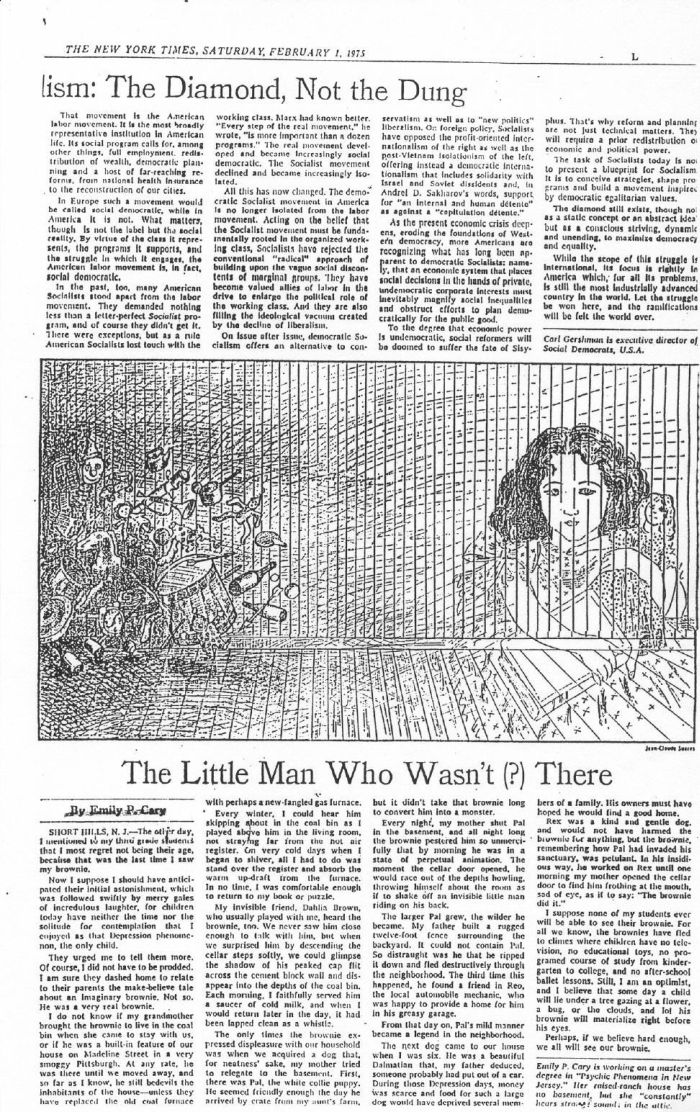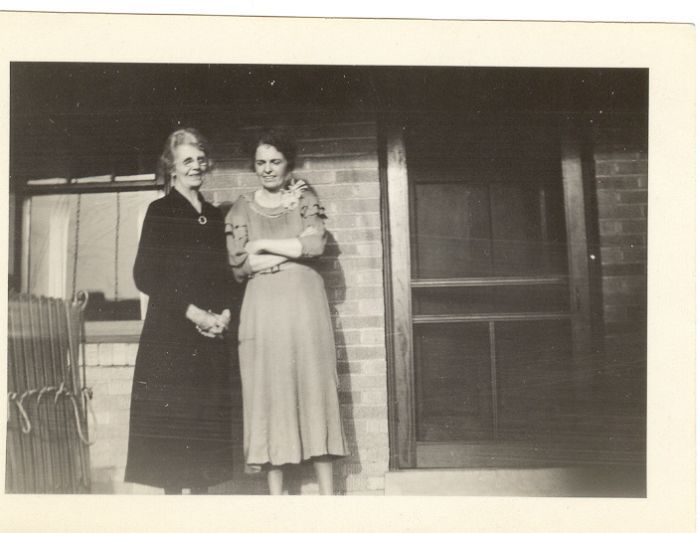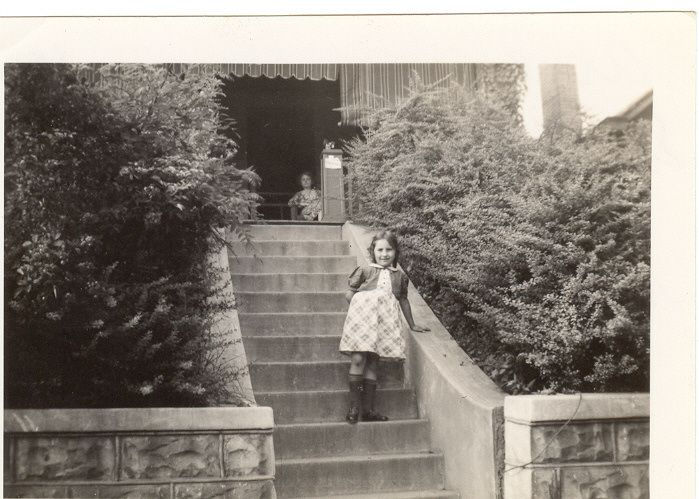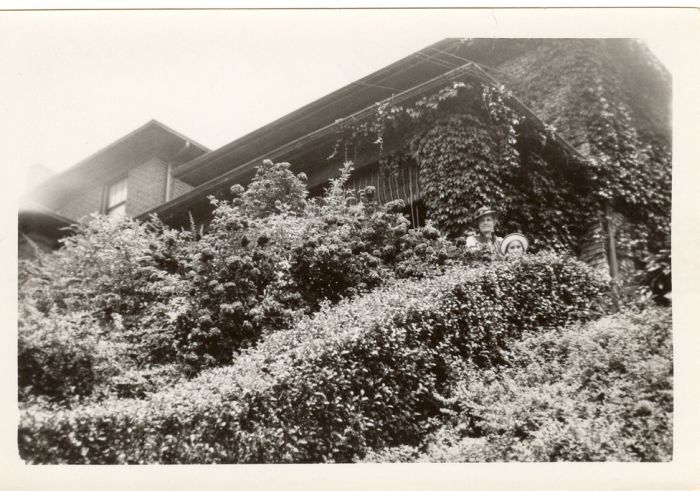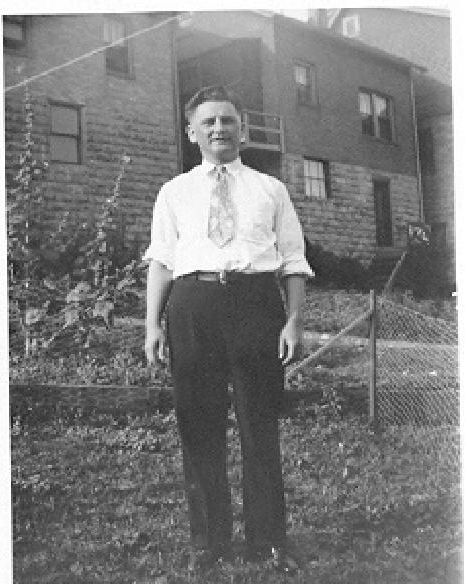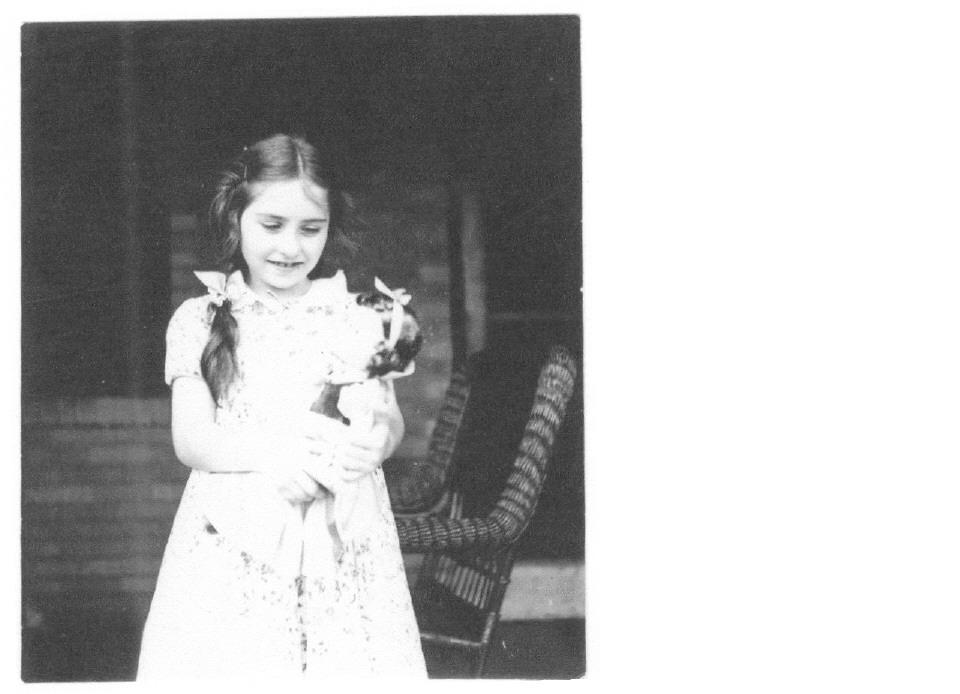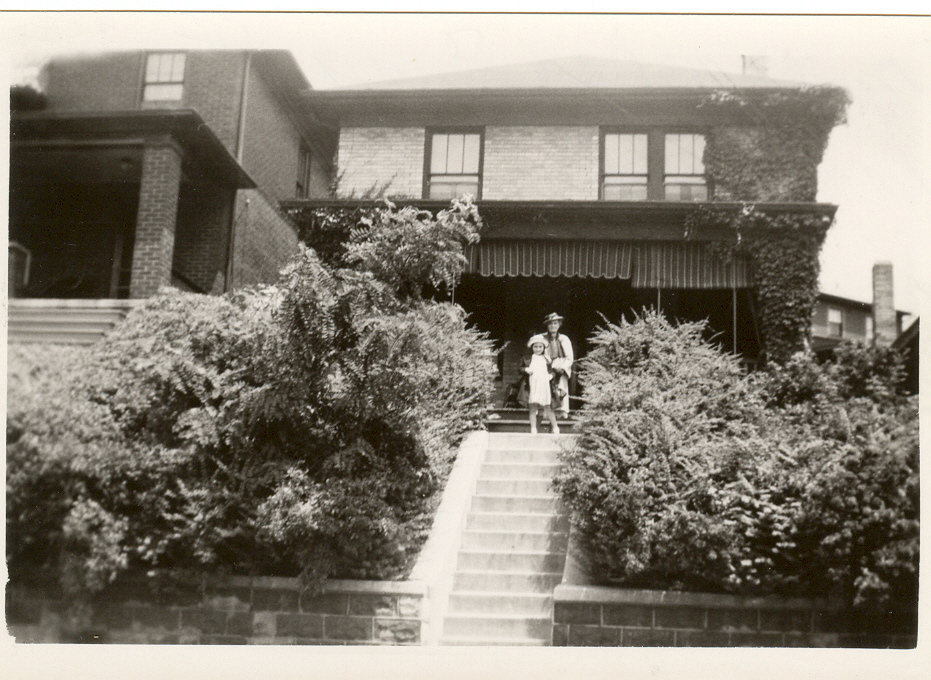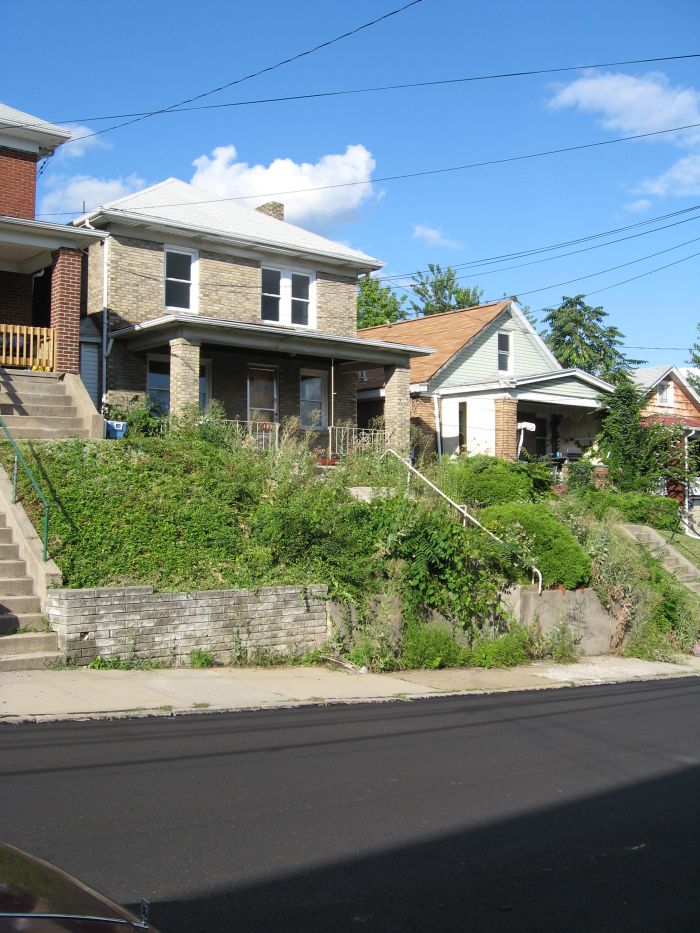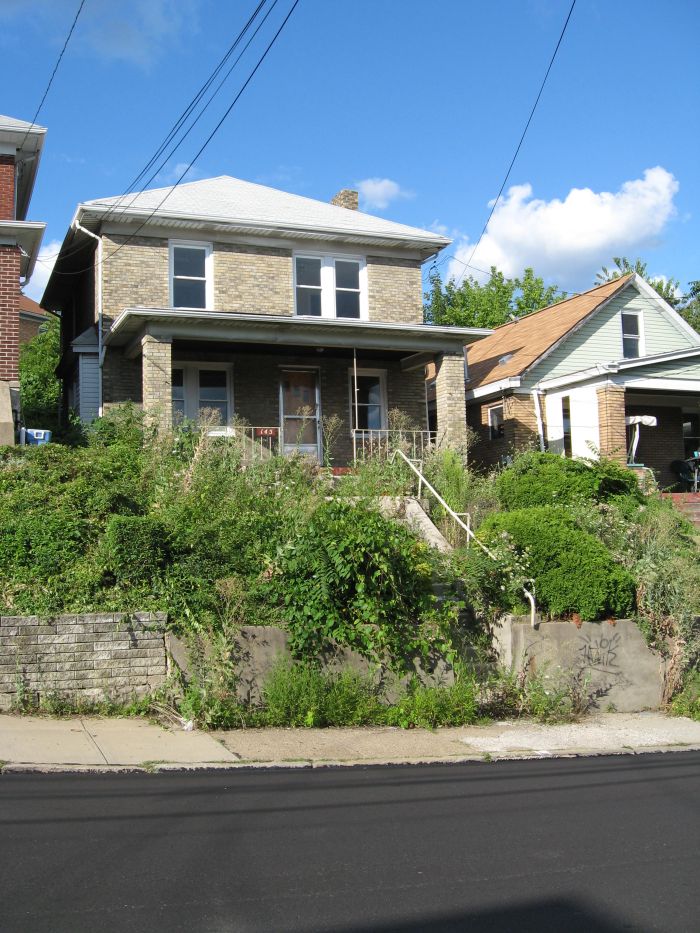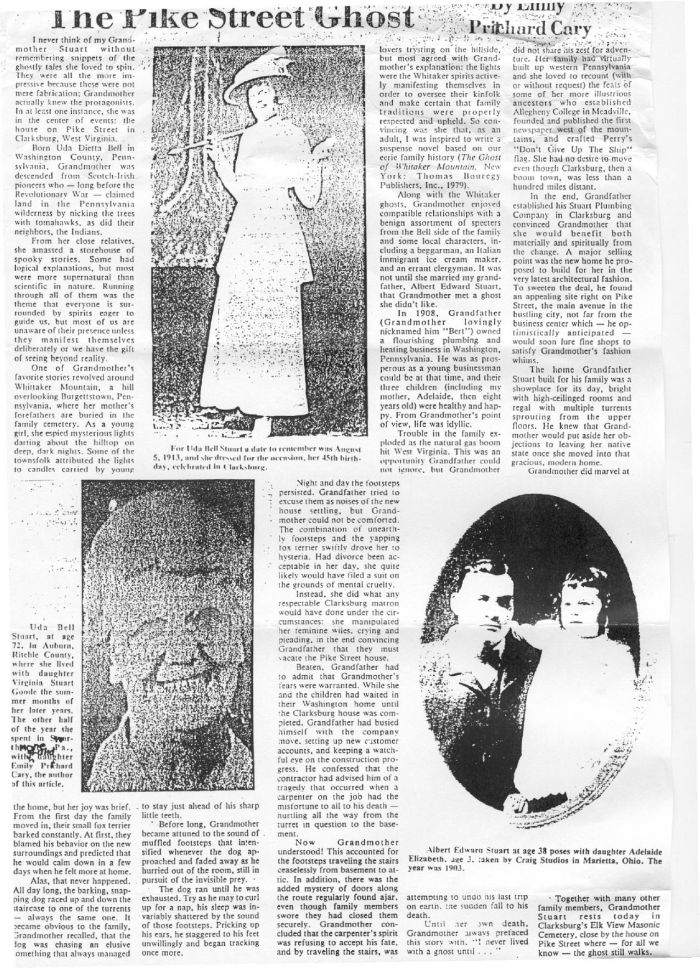Emily Prichard Cary
Contents
- 1 Emily Pritchard Cary wrote the story under the subject Depression Life in the Carrick Glossary of Terms. You can click here to see as it appears in the Pittsburgh Post-Gazette.
- 2 Emily Prichard Cary's story about a Brownie in the house at 145 Madeline Street
- 3 1933 Madeline is of my grandmother, Uda Bell Stuart, and my mother, Adelaide Stuart Pritchard standing at the front door.
- 4 The Madeline staircase is of me halfway down to the bottom (being watched very carefully by my grandmother on the porch in case kidnappers happen by).
- 5 The Madeline bushes shot was taken of Mother and me one Easter Sunday in our finery peering over the bushes. I can't get over all the greenery. It looks as if the house is bathed in vines.
- 6 This is my father, Ernest Pritchard, standing in front of the hollyhocks in our backyard. To his left (out of the picture) is our one-car garage. My mother learned to drive coming down the steep alley and making K-turns into the garage. The houses behind him are on Scout Street. I believe that the one on the left was occupied by the Lowe family. The one to its right by the Haas family. (Their daughter, Valerie, had diabetes, very rare for children in those days. Today about half of the children in every Phoenix classroom has it.)
- 7 Incidentally, the photo sent previously of my father in the backyard does not show the Steck house on the corner of Scout and the alley. Jim Steck worked for AT&T, but was laid off (the only one so tapped in my father's group). My parents were so embarrassed that Father went to the boss and offered to take Jim's place, but was told that they had been looking for a way to get rid of him and nothing anyone could do would make them change their minds. Within a few months, Jim Steck was hired as an on-air announcer at one of the Pittsburgh radio stations and prospered far better than his former co-workers. They soon bought a very fancy house in Brentwood. Only after confirming the entire family died did I dare write about his wife, whom my grandmother feared would go to the devil because she smoked and wore slacks, and their erramt child, Bunky, who strangled cats, damaged everything in the neighborhood he touched, and ended up dying in a California prison.
- 8 I just found this copy of the prize photo taken by Harry Lynch. My grandmother became deaf following the 1919 flu epidemic as did Harry, the son of her friend. He attended the Deaf School in Pittsburgh majoring in photography and every year or so would come around to take our pictures. He spent hours posing us in every conceivable situation and always stayed long enough to partake of a hearty meal. On this occasion, I was exhausted from riding my tricyle, swinging on the swing, playing jacks, and doing whatever else he asked of me. When I burst into tears and picked up my Snow White doll (which I'd earned by not crying when Dr. Askins - office on Brownsville Road - lanced my ear for the seventh time), he took the final picture. Incredibly, it won first prize in a city-wide contest.
- 9 Here are two views of 145 Madeline street. The Strouds lived to our right (red brick) and the Richters to our left. They had come from Germany after WWI. During WWII, the Strouds told us that the Richters were accused of being Nazi sympathizers, even though they weren't. Their son, Fritz, taught in a Pittsburgh high school. When I study the 1930 census, I see that many of the people living on or near Madeline Street had come from Germany. My mother loved being near them because they were so clean and the food they shared was delicious.
- 10 145 Madeline Street, 8/15/08
- 11 145 Madeline Street, 8/15/08
- 12 A Short Story by Emily Pritchard Cary
Emily Pritchard Cary wrote the story under the subject Depression Life in the Carrick Glossary of Terms. You can click here to see as it appears in the Pittsburgh Post-Gazette.
Emily Prichard Cary's story about a Brownie in the house at 145 Madeline Street
Did the Brownie really exist? Emily Cary writes: "Your guess about the Brownie is as good as mine. Grandmother told so many strange and eerie stories that I remember covering my head every night in bed so the creatures in the closet and under the bed couldn't find me. Many took the form of Mandrake the Magician and Punjab from the comic pages of the day. I went to bed a perpetual state of fear. The Strouds who lived next door believed that our house on Madeline Street (which Mrs. Stroud's somewhat wealthy Brentwood uncle, Mr. Breckbill, bought as an investment) had at least one ghost because a previous resident died there. We never had other major encounters with ghosts until I was in college and my parents moved into a house a few miles from the one in Swarthmore where we had lived since coming from Pittsburgh. It was only after I mentioned feeling chills up and down my back every time I sat in a chair near a certain window that they told me the previous owner, a doctor, had shot himself next to that window. His wife and daughter found him there. They immediately moved out and rented it for a mere pittance. My parents thought it was a deal they couldn't refuse and mother didn't object to the ghost because she had endured them many times throughout her life, courtesy of her own mother.
Our dogs did go crazy; however, my father later believed that Rex, the Dalmatian, developed distemper from sleeping in the cold before we took him in. We had him for the better part of a year, so who knows what transpired. Pal, the Collie, thrived for years in the garage that was a block or so down the hill from us on the opposite side of the street (next to a steep alley, I recall). Reo, the mechanic who took him in, had a red face and sweat constantly poured down his face and neck. He regularly offered me a "chaw" of his tobacco which I eagerly accepted (until my father snatched it away from me), believing it to be chocolate."
1933 Madeline is of my grandmother, Uda Bell Stuart, and my mother, Adelaide Stuart Pritchard standing at the front door.
The Madeline staircase is of me halfway down to the bottom (being watched very carefully by my grandmother on the porch in case kidnappers happen by).
The Madeline bushes shot was taken of Mother and me one Easter Sunday in our finery peering over the bushes. I can't get over all the greenery. It looks as if the house is bathed in vines.
This is my father, Ernest Pritchard, standing in front of the hollyhocks in our backyard. To his left (out of the picture) is our one-car garage. My mother learned to drive coming down the steep alley and making K-turns into the garage. The houses behind him are on Scout Street. I believe that the one on the left was occupied by the Lowe family. The one to its right by the Haas family. (Their daughter, Valerie, had diabetes, very rare for children in those days. Today about half of the children in every Phoenix classroom has it.)
Incidentally, the photo sent previously of my father in the backyard does not show the Steck house on the corner of Scout and the alley. Jim Steck worked for AT&T, but was laid off (the only one so tapped in my father's group). My parents were so embarrassed that Father went to the boss and offered to take Jim's place, but was told that they had been looking for a way to get rid of him and nothing anyone could do would make them change their minds. Within a few months, Jim Steck was hired as an on-air announcer at one of the Pittsburgh radio stations and prospered far better than his former co-workers. They soon bought a very fancy house in Brentwood. Only after confirming the entire family died did I dare write about his wife, whom my grandmother feared would go to the devil because she smoked and wore slacks, and their erramt child, Bunky, who strangled cats, damaged everything in the neighborhood he touched, and ended up dying in a California prison.
I just found this copy of the prize photo taken by Harry Lynch. My grandmother became deaf following the 1919 flu epidemic as did Harry, the son of her friend. He attended the Deaf School in Pittsburgh majoring in photography and every year or so would come around to take our pictures. He spent hours posing us in every conceivable situation and always stayed long enough to partake of a hearty meal. On this occasion, I was exhausted from riding my tricyle, swinging on the swing, playing jacks, and doing whatever else he asked of me. When I burst into tears and picked up my Snow White doll (which I'd earned by not crying when Dr. Askins - office on Brownsville Road - lanced my ear for the seventh time), he took the final picture. Incredibly, it won first prize in a city-wide contest.
145 Madeline Street, 8/15/08
145 Madeline Street, 8/15/08
From Emily Prichard Cary to John Rudiak on 8-16-08:
"The house at 145 Madeline Street looks to be very much as it was the last I saw it about 30 years ago. I'm sure much of the credit goes to the sturdy brick construction typical of pre-war Pittsburgh. I see that the shrubbery is overgrown today, as it was when we were there. I remember being scratched daily by the barberry bushes.
I'm pleased that you like the piece appearing in the Post-Gazette. Over the years, I've written quite a bit about growing up in Pittsburgh during the Depression. The first article published appeared Feb. 1, 1975 on the New York Times Op Ed Page. At the time, a prominent book editor fell in love with it and asked me to write my memoirs, but I was busy teaching and declined for lack of time. When I finally got around to tackling the project, she had died. Which only goes to show my grandmother was right about striking when the iron is hot. I'll send you a copy of the piece, which I hope is readable. I believe that it can still be accessed on the New York Times archives web site. It reminisces about the house, the coal furnace, and the brownie that my grandmother swore lived in the coal bin to bring us good luck.
My mother was not so certain about the good luck aspect of the place. Just six months after my parents built their dream house on Rolling Hills Road in Baldwin Manor, AT&T transferred my father to the Philadelphia office. It meant leaving all their friends and going to a strange city where Mother was disqualified from teaching (which she had loved doing before their marriage) because of the ban against married women in the classroom. She cried all the way along the Pennsylvania Turnpike to our new home in Swarthmore, a suburb of Philly. Every time I drive that road, I remember that day and wonder how my father was able to concentrate on driving.
We arrived there two months before Pearl Harbor. The next year, Mother had a reprieve. Permitted to teach again and take the place of a drafted male teacher, she thrived once more and continued teaching until just a few months before her death in 1969.
Several of my recent Pittsburgh stories have won first prizes from the Southern California Genealogical Society. One about my ancestor who made the "Don't Give Up The Ship" flag is in an anthology published by Heritage Publishers, which also published three editions of my Pritchard Family History, the latest updated in 2006.
So many of my stories go back to Pittsburgh and my family. One tale my grandmother told about mysterious events in Washington County, Pennsylvania ended up in "The Ghost of Whitaker Mountain." When the book first came out, I was invited to speak at the Carnegie Library in Burgettstown. Although I had planned to visit Carrick that day, there simply wasn't time to catch my plane back to Washington (we lived in Fairfax, Virginia at the time). So I was delighted to receive a request from the English Department at Burgettstown High School to give a writing workshop a year ago last February. My husband and I planned to spend several days in Pittsburgh at that time, but one month before we were scheduled to leave, he had a stroke and heart attack. Although he is pretty much back to normal, we haven't had another opportunity during the interim to visit there. I hope we make it back before U.S. Airways (the only carrier that flies there from Phoenix) goes out of business.
My father, who always enjoyed taking long walks around Carrick, was pleased to discover that one of our new neighbors in Swarthmore was Jim Hornaday, the son (or perhaps grandson) of William T. Hornaday. Jim Hornaday, Jr. was a year ahead of me in Swarthmore High School. My father and Mr. Hornaday walked to the train station every day and frequently reminisced about Pittsburgh.
Not long ago, I found a photo of the old Concord School (circa late 1800s) on a Pittsburgh web site. That is where I first started school. Unfortunately, the principal insisted that I enter second grade at age 5, having learned to read at two. My parents were thrilled, but it took me years to catch up in math and phys ed. My penmanship is illegible to this day (never could master those Zaner-Blozer ovals) and I was the only one in my classes throughout school who couldn't do a cartwheel. Such are the disadvantages of being pushed academically.
I have so many stories about Pittsburgh during the Depression that I'd love to combine them all in a book one day. Some are sad, like the death of a classmate from the flu during the floods; others are exciting, like my Mother's discovery of a player piano for $7 (with free delivery) at a music store in Mount Oliver; still others are funny, like the deaf mute (son of my grandmother's friend)who visited our house regularly and won first prize for a photo he took of me with my Snow White doll after posing me for more than an hour and eventually driving me to tears. The player piano enabled Mother to earn extra money giving piano lessons in our basement for 25 cents a week and gave me enormous pleasure. The Depression certainly was a critical time in this nation's history; sadly many of the lessons learned then may have to be relearned by future generations.
To add to the Halloween stories, the one I've attached is true. My grandmother was a firm believer in ghosts and this one actually had a logical basis. Because of it, she forced my grandfather to move the family to another house.
Another of Grandmother's ghost stories was the impetus behind my book, "The Ghost of Whitaker Mountain." It's set in Burgettstown, Washington County, where she lived until a teenager. Her father then moved to Meadville (touted at the time as Pennsylvania's third finest city) and became the owner of the city's first Singer Sewing Machine agency. (We had her original Singer until 1970.) My cousin, who now lives in Apollo, PA, tells me that the Whitaker ghost was recognized and accepted by elderly Burgettstown citizens at least until she entered high school.
A Short Story by Emily Pritchard Cary
Everyone needs a fearless role model. Mine was my mother.
Soon after I entered second grade, Mother convinced Father that my constant earaches were caused by the long, cold walk back and forth to school. Having grown up in a community with ample public transportation, she had never learned to drive. And so, to preserve my health, Father agreed to teach her.
For the next few months, Mother spent each weekend in the driver’s seat. Father patiently instructed her from the passenger side. I sat in the back with Grandmother, who was hard of hearing. From our vantage point, the city’s hills were every bit as scary as Kennywood Park’s giant roller coaster.
Seat belts were not yet invented, so we pitched forward without warning each time Mother stalled the engine, unable to shift the cumbersome floor gears. Father gritted his teeth. I giggled. Grandmother straightened her hat and gasped, “Oh, my!”
Once she mastered our second-hand 1932 Chevrolet, Mother was in her glory. Some of her bravest moves came while Grandmother was enthroned on the back seat shouting nonsensical traffic warnings. Not even heavy snowstorms deterred her from zipping around town on streets layered with coal cinders. (She never realized that a car could skid on ice until many years later when a death in the family necessitated driving from Philadelphia to Pittsburgh on the Pennsylvania Turnpike. After the car did a 180 degree turn and was facing back toward Philadelphia, she insisted that Dad return home and telephone their regrets.)
Mother’s most adventurous drive occurred the summer she and I moved Grandmother from my aunt’s home in West Virginia. A widow, Grandmother spent half of the year with us in Pittsburgh and the other half with her other daughter in Auburn, a tiny town in Ritchie County, West Virginia. She loved us all, but complained that the country was boring.
When her annual barrage of letters begging us to bring her back to the city began arriving, Father could not take time off work. The only solution was for Mother and me to go alone.
Father assembled maps for our journey. Mother’s task was to operate the car and mind the traffic; mine was to follow our route. I outlined the roads we would take with purple crayon and studied the plans until I knew them by heart.
Mother dismissed Father’s warning that twenty miles of a narrow, rocky road between Pennsboro and Auburn, West Virginia might be a problem. She mastered the rough course by traveling at a crawl, ignoring the long line of farm trucks tailing us. All were driven by impatient, burly men.
Squinting back through the dusty windshields of the trucks nearest us, I made out red faces shouting words we neither understood nor wished to acknowledge.
“They have no manners,” Mother said. “I have every right to drive slowly. I’m sure we’ll all get where we’re going in due time.”
Except for assembling Grandmother’s belongings for the return trip, everything went smoothly - until we reached the city of Fairmont.
Our route took us through the city center directly up a hill that disappeared into the sky. It had not worried Mother when we approached from the opposite direction headed downhill. Northbound, however, we had to scale its heights if we expected to get out of town. But after clearing a light at the bottom of the hill, we ran into a blockade half way up: a busy cross-street with another stoplight that was timed to turn red at the very moment we arrived.
Once the signal flashed green, Mother tried to shift into low gear, but somewhere in the netherworld between the moment she began to release the clutch and the instant the transmission rallied into first gear (or was supposed to), the car began slipping backwards.
Not once. Not twice. Eight times we backed all the way down the hill, Grandmother gesturing wildly from the rear window to warn the hapless drivers behind us to clear a path. By starting on the level, Mother gained momentum up the hill, but each time we approached the cross-street, the amber light flashed to red, and she slammed on the brakes. No matter how she struggled to shift gears when the green signal reappeared, she could not get her foot off the brake quickly enough to accelerate. Suspended in neutral, we rolled backward with terrifying finality.
During our rapid descents, Mother wove in and out of the cars behind us like a race car professional. Drivers gasped in disbelief. Many shook their fists at us. Grandmother shook hers right back.
After the eighth descent, Mother made a dramatic decision. “We’re going through the next time, no matter what.” She signaled Grandmother to hold onto her hat, then instructed me, “Emily, start honking the horn for all you’re worth!”
With that, Mother leaned into the steering wheel and gunned the engine while I planted my small fist on the horn in an ear-splitting alert. As we barreled through the red light, unsuspecting drivers were entering the intersection from the cross-street. One mounted the sidewalk to avoid a collision; others were so stunned they stalled their engines.
Leaving them behind in our dust, we soared to the top where Mother exclaimed, “We did it!”
“Hooray!” I cried, proud to share in her success.
As we pulled into our driveway, Dad rushed to welcome us and asked, “How was your trip?
Mother smiled serenely. “As easy as pie.”
Of course he missed the warning look she tossed me.
And we didn’t tell. Not for years.
